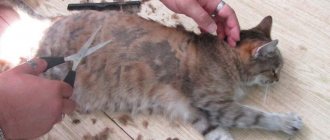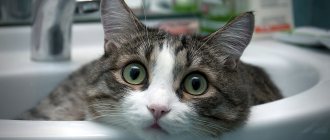Toilet training is something that many cat owners take for granted. Even rescued cats seem to instinctively know how to use the litter box by copying their mothers. However, some felines may not have survived this important socialization. Thus, older cats may need to be toilet trained from scratch or they will defecate outside the litter box.
Do not use a covered litter box as this may frighten a cat who is not familiar with the process. Use unscented litter that is similar to your cat's usual outdoor surfaces. Leave the litter box in a place where the cat can have privacy, such as behind a plant.
An adult cat can learn to use the litter box correctly after training. There may be a little confusion along the way, such as sleeping in a litter box. Over time, your cat will begin to understand what is expected of her.
Features of training an adult cat
Is it possible to train an adult cat to use a litter box? Of course yes! But let’s immediately agree that you are the owner of the house, not the cat. You are smarter, stronger, you have more opportunities. This means that it is you who bears the responsibility for raising the animal and arranging its living space. The pet is completely dependent on you, which means your task is to place the toilet so that it is convenient for the pet to go to it. To do this, you will have to be patient and not wait for quick results.
If you are adopting an adult domestic cat, be sure to ask where his litter box was, what it looked like, and what kind of litter was used. You can ask the owners for an old tray for the first time - the cat knows it and knows why it is needed. Buy the same filler. Try to reproduce the environment your cat is familiar with at home. This way the animal will be less stressed, and it will immediately figure out where to “do things.”
When the cat gets used to the house, you can buy a new tray and, if necessary, gradually retrain it to a new placement, for example, not in the hallway, but in the bathroom or toilet. At the same time, you should limit access to undesirable places and hide things that your pet “encroaches” on: close the door to the bedroom, cover your favorite chair with oilcloth, hide slippers or other shoes, tightly close the cabinet with bed linen, blankets, etc.
With street cats the situation is more complicated. You know practically nothing about the animal and its habits. How long does it take to litter train an adult outdoor cat? In each case, it depends on you and the cat, that is, strictly individually. Some pets understand where to go to the toilet from the first hours in their new home, while others need weeks to figure it out. Therefore, you will have to be patient and empirically search for a toilet option that suits you and your pet.
An adult cat's character has already been formed, so you will have to be creative to achieve the desired result. No aggression! No screaming and, especially, no physical punishment! Only affection and patience will help your cat develop the skill you need.
How to toilet train an adult street cat is not an easy question. Typically, animals taken from the street find any quiet corner suitable for satisfying their natural needs. And if you scold the animal, it will look for more and more secluded corners. Each time, searching for and cleaning up the “consequences” will become more and more tedious. Therefore, it is worth asking the question: how to accustom a cat to an adult litter box - without stress and forever.
There are a number of factors to take into account here:
- type and size of the tray;
- filler;
- the place where the toilet is located;
- character traits of the animal.
Choosing a place for the toilet
Cats are delicate creatures. They choose secluded corners, hidden from prying eyes, as a latrine. Therefore, you also need to choose such a place for the tray in the house. The most suitable place to place a cat litter box in an apartment would be a bathroom or toilet, as well as a balcony (loggia), if it is insulated. In addition, do not forget that the animal must be able to freely approach its toilet at any time. This will allow you to quickly and easily accustom your cat to the new toilet.
The kitchen and hallway are absolutely not suitable for cat litter. Firstly, this is unacceptable from the point of view of apartment hygiene. Agree that a toilet (even a cat’s) has no place in the kitchen, where food is prepared, or in the hallway, where people dress and put on their shoes. A generally suitable place can be considered a pantry if it is convenient for you and your cat. Secondly, a cat may refuse to use the toilet where people are often: she, as already mentioned, is a delicate creature.
How to choose a tray and filler
If you are adopting an adult domestic cat from other owners, you can ask for a litter box. And if this is not possible, then ask what kind of toilet the cat had and what kind of litter the previous owners used. And at the same time, find out if your pet has a habit of marking the territory outside the toilet. If precedents have occurred, you may want to try a different filler.
Experience shows that you can accustom a cat to the litter box of an adult from the street quite quickly if you choose the right litter box and litter. Typically, such pets prefer wood or bentonite (clay) filler, as well as sand. They have a natural smell and are perceived by cats as more familiar and understandable. But scented fillers or silica gel rustling under the paws can scare away the animal.
The granules must be of the optimal size. Such that it doesn’t put pressure on the cat’s paws and doesn’t make it difficult for him to move in the litter box. If a small kitten or a cat with problems with its paws is given large granules that cause discomfort, the animal will most likely stop going to the litter box until the filler is changed to a more comfortable one.
The tray should be high enough, with sides at least 10 cm high, so that when burying excrement, the cat does not scatter the litter on the floor. To avoid unnecessary cleaning, you can buy a cat litter with a frame. But keep in mind that high sides can be a problem for kittens and small cats. The problem can be solved if you purchase a tray with one low edge, which will be comfortable for even a small kitten to step over.
It is easier to train an adult cat to use a litter box if the tray is the right size. A large animal that requires a lot of space in the toilet will simply ignore a small tray.
The question: how to accustom an adult cat to a litter box without litter arises most often when the cat manages to pour almost all of the litter onto the floor in the process of burying secretions. How to accustom an adult cat to a litter box with a mesh?
You should begin the process of “relocating” to a tray with a mesh only after the cat consistently goes to the toilet in the designated place. Then you can gradually reduce the amount of filler, and then replace it with newspaper or pieces of toilet paper. The animal will get used to the absence of filler, and then you can offer it a tray with a mesh. For the best effect, we recommend treating the new tray with a toilet training product, which can be purchased at pet stores and veterinary pharmacies.
Which filler is better?
The choice of filler is a purely individual question for each cat. Some pets do not recognize granules with flavorings, some are unpretentious and do without any filler at all. First of all, the owner should pay attention to the harmlessness of sand for the cat's litter box. A high-quality filler meets the following requirements:
- practically no dust;
- does not have too strong fragrance;
- does not pose a threat when eaten;
- quickly absorbs moisture;
- does not stick to the animal's paws.
Poor quality can cause an allergic reaction in cats and their owners, leaving a “swamp” in the tray.
For an adult animal, you can use wood pellets, bentonite clay or silica gel, depending on the pet's choice.
How to train a cat to use a litter box
Adult cats need to be trained to use the litter box gradually. First, show the animal the tray, rustle with the litter, let it sniff and examine it. It is advisable to place the tray in a quiet corner, since cats are “embarrassed” to go to the toilet in plain sight; they need a quiet, comfortable place. A bathroom or toilet room or a corner of the corridor are perfect.
If your pet likes the place, he will start using the toilet from the first day, and you will not have any problems. But you’re not always so lucky; often the cat shits in places other than where you suggest it. How to proceed in this case?
You need to collect excrement with a napkin or spatula, transfer it to a tray, put it in it and show it to the animal. You can even try to “bury” them with his paw.
Secondly, the “wrong” place must be thoroughly washed with a special detergent, treated with a spray to wean cats off the toilet, or rubbed with lemon or orange peel. Animals do not like this smell and will avoid this corner. Thirdly, you can completely stop access to an unwanted place: close the door to the room, temporarily put some furniture in the corner.
Another option is to place the tray in the corner where the cat goes to relieve himself, and when he gets used to the tray, gradually move it to the place you need and praise and treat your pet with treats for a successful “visit” to the toilet. Positive motivation usually works very well with these smart animals.
If your cat stubbornly refuses to go to the toilet, observe her behavior. The pet definitely doesn’t do this “out of spite”; he has his own reasons for ignoring the tray. Your task is to figure out what's going on.
There can be many reasons:
- puberty or period of sexual arousal;
- disease, most often of the bladder or kidneys;
- the appearance of another cat or other pet in the house;
- unpleasant filler or odor in the place where the toilet is located.
In this case, you need to act according to the circumstances: take the animal to the veterinarians, sterilize it, buy another filler or air freshener, etc.
A lot of patience
Cats are sensitive to human emotions. In case of failures with litter box training, you need to try to find and eliminate the cause before taking out your irritation on the animal. Cats mark corners not to spite the owner, but because something confuses them in the place designated for the toilet. Take a closer look at your pet; perhaps he is uncomfortable in the new tray, the filler is too large and scratches his paws, or has an unpleasant aroma for the pet.
By eliminating negative factors and arranging comfortable conditions for the pet, the owner will be able to ensure that the animal visits the litter box without mistakes and get an affectionate, contented and purring friend.
Is it worth punishing if the cat does not go to the litter box?
If the question of how to accustom an adult cat to a litter box in a new home is not resolved immediately, shouting or resorting to physical punishment is not only unnecessary, but also harmful. Cats are excellent at distinguishing intonation, and your dissatisfied voice will be a signal that “something is wrong.” The animal will be offended by shouting or beating and will deliberately spoil your things.
Moreover, in order to hide the Skoda, the cat will begin to look for more and more inaccessible and hidden places. As a result, the smell will spread throughout the house, and it will become more and more difficult for you to find its source each time. The cat will have negative associations with the litter box, and it will be even more difficult to train your pet to use it.
Don’t be lazy each time to explain to your pet what is required, take the excrement to the tray and bury it. You can even try burying the waste with your pet’s paw, and then praise it and treat it to something tasty. Usually, after 3-5 repetitions of this procedure, cats themselves begin to run around the house at the right moment in search of the “right” place for the toilet.
If the cat periodically “does not get” to the intended place, it is worth showing it to a veterinarian. Perhaps the animal has pain in the kidneys or genitourinary organs.
What to avoid?
It is strictly not recommended to strictly punish a cat for mistakes. Under no circumstances should you humiliate an animal, poke its face in feces, shout or spank it. Cats are very sensitive to violation of personal boundaries, quickly lose trust and form unpleasant associations with the litter box and the process of emptying in general. If handled incorrectly, the pet will decide that shitting is generally bad, and will begin to look for “nicks” in order to relieve itself without the knowledge of the owner, in secret. It is much more difficult to retrain such an animal than simply an ignorant one.
Also try to avoid loud noises while the cat is in the process. Don’t drive it away right away, let it dig around without haste.
How to stop an adult cat from shitting
To protect your home and furniture from being “mined” by your cat, experts recommend starting with studying the animal’s health. He may need to be treated. If the cause of the marks is hormonal activity, it is recommended to sterilize the pet.
Uncontrollable urination can be caused by diseases, including infectious diseases caused by flea bites and other parasites. Therefore, take care of hygiene and regularly wash your pet with special shampoos, wear an anti-parasitic collar and be sure to treat it with a spray or other insecticidal preparations during the insect active season.
It is also recommended to take the following measures:
- make it difficult or completely block access to an unwanted toilet area;
- provide free access to the tray;
- wash the unwanted area with detergents and treat it with a special spray or citrus essential oil, and treat the tray with a spray that attracts the animal’s attention;
- praise, stroke and pamper with delicious food every time the cat visits the tray;
- try several litters and buy only the one that your cat likes: so that it absorbs moisture and odors and does not cause discomfort.
Why doesn't an adult cat use the litter box?
Some cats are homeless or feral. This means they never received the socialization needed to become a pet. Sometimes a kitten is born into the family home but is rejected by its mother.
This means he was never taught basic functions. Some cats are also abused by other pets. This could make them afraid to use the litter box due to the smell. Another animal could even "stand guard" over the litter box, preventing your cat from entering.
© shutterstock
Timely training
It is advisable to accustom a kitten to the tray from an early age. From which one?
As soon as possible, ideally when he reaches four weeks.
Teaching a one-month-old kitten to order will be quite quick and easy.
According to the advice of veterinarians, this particular age limit is optimal for animals to learn new information and skills.
But this requires persistence on the part of the owner.
If the owner does not pay attention to the “dirty things” left in the corners of the apartment and silently removes them, then the pet will decide that this is in the order of things
Important! It is much more difficult to teach order to a two-month-old kitten, especially after he has been pooping wherever he wants for quite a long time!
If you took the baby from a nursery, where until now his mother was looking after him, then you should not flatter yourself with the hope that she instilled good behavior in him.
As a rule, cats do not train their kittens to use the litter box. Kids can simply copy her actions.
And even if small pets managed to adopt some good habits during the time spent next to her, there is a high probability that the skills will be lost when the situation changes.
Even if the cat mother set an exceptionally good example for the baby, separation from her can lead to a complete loss of this experience.
When a kitten turns one month old and is immediately separated from its mother, it experiences stress, no matter how friendly its new owners are to it.
The baby is lost and often does not control his natural urges.
Here, new owners should show restraint and teach the kitten to go to the litter box on their own.
How long will it take? It all depends on your persistence and the character of the baby.
Tray selection
Looking at a one-month-old kitten, many people think that it needs the smallest tray.
You can learn how to determine the age of a kitten from the article
But it is not so. Taking care of the baby in this case is quite understandable, but it should be remembered that the animal will grow quite quickly.
The weeks will fly by unnoticed: today the kitten is a month old, and after, it would seem, a couple of days he is already 1.5 months old, a little more and he has reached two months of age.
Before you even blink your eye, the furry baby will turn into a respectable cat that no longer fits in its toilet.
And if you are the happy owner of one of the large breeds , such as Maine Coon , Ragdoll or Savannah , then in this case the smallest toilet is out of the question.
If you rely on the advice of veterinarians, then you should immediately purchase a tray with sides of about 8-10 cm: the pet can easily overcome them, the main thing is that he wants to do it.
But the height should not be too high.
In any case, as the animal grows, you will have to change its litter box to a larger one once or twice.
And in order to accustom a kitten to the litter box fairly quickly, it is necessary that it meets the following requirements:
- complete absence of foreign odors;
- the material from which the toilet is made should not oxidize upon contact with feces;
- The tray should not rattle when the kitten tries to cover its “footprints”, otherwise it will scare it.
The baby should feel comfortable and safe
Thus, it turns out that the most suitable option is a plastic tray.
It may come complete with a grille or be without it.
What to buy is up to you, but here you need to take into account that a toilet with a grate is more convenient to use.
This way, liquid feces will pass through it, and your pet’s paws and fur will remain clean.
This aspect is especially relevant when your apartment contains a representative of one of the long-haired breeds, for example, a Persian , Siberian , or Norwegian cat .











